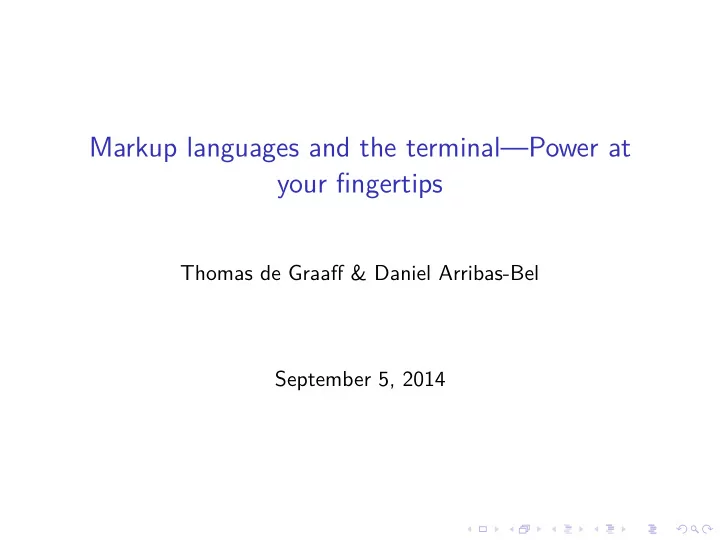

Markup languages and the terminal—Power at your fingertips Thomas de Graaff & Daniel Arribas-Bel September 5, 2014
Introduction
Recap Our main goal: To make our research as reproducable and visible as possible This entails: 1. Sharing of code 2. Sharing of data (if possible and not proprietary nor privacy sensitive) 3. Sharing of output (presentation, article, website)
The power of plain text 1. Ubiquitous 2. Usually small in size 3. Portable across platforms (and versions) ◮ it will not be obsolote soon ◮ everyone can read it everywhere 4. It is scriptable (both as input as output) ◮ code is almost always in text format ◮ usually data is in text format as well ◮ but underlying format for output (presentation, website, tables, articles, books) can be text as well
Manipulation of text ◮ Most output is based on simple text file; applications only change appearance, such as: ◮ browsers ◮ pdf ◮ How to change appearance require markup-languages ◮ HTML ◮ LaTeX ◮ Markdown
Latex and friends
LaTeX 1. What? ◮ A set of macros around Tex , a markup language invented by Donald Knuth 2. How? ◮ Latex is a document preparation system and document markup language. Source: Wikipedia 3. Why? ◮ Defacto standard in academic publishing ◮ Formulae used in HTML pages (e.g., Wikipedia) ◮ Macro’s thus scriptable (whoohoo) 4. But. . . ◮ Notation a bit cumbersome ◮ For small texts a bit too much and not geared for HTML (see also)
A minimal example \documentclass[12pt]{article} \begin{document} \section{My Paper} I just discovered that: \begin{equation} e=mc^2 \end{equation} \end{document}
Bibtex ◮ Basically a free reference manager (actually more a style of managing references) ◮ Very versatile and very powerful (most other markup languages work with bibtex as well) ◮ Free managers, such as bibdesk or mendeley, are now ubiquitous
Markdown
Why markdown? 1. Easy to learn http://daringfireball.net/projects/markdown/ 2. Much less notation than Latex . Originally, ◮ LaTeX is for paper (aka dead trees) ◮ Markdown is for HTML (blogs, wikipedia and so) ◮ but sneakily uses some Latex when needed 3. Focus on text 4. Nowadays: ◮ “easily” change it in html or pdf (via Latex)—even in Word if needed ◮ can be extended with code or—much better—its results
Small diversion Question 1: Why and when do we make use of pdf’s and not html? Question 2: Is one always better than the other?
Language syntax Emphasis: *italic* **bold** _italic_ __bold__ Headers: # Header 1 ## Header 2 ### Header 3
Language syntax (cont.) Unordened lists * Item 1 * Item 2 + Item 2a + Item 2b Ordered List 1. Item 1 2. Item 2 3. Item 3 + Item 3a + Item 3b
Language syntax (cont.) Links: http://assemble.io/docs/Cheatsheet-Markdown.html [Cheatsheet](http://assemble.io/docs/Cheatsheet-Markdown.html) Images:  
Language syntax (cont.) Code blocks: markdown python s = “Python syntax highlighting” print s which renders as: s = "Python syntax highlighting" print s
Language syntax (cont.) To embed mathematics ‘just’ use Latex notation: $$e=mc^2$$ which surprisingly looks as excel type of formulae and renders as: e = mc 2
Language syntax (cont.) Inline equations just require $ $ , e.g.: In economics it is well kwown that: $\frac{d x}{d y} = -\frac{ \partial u(x,y)/ \partial y} { \partial u(x,y)/ \partial x}$. which renders as dy = − ∂ u ( x , y ) /∂ y In economics it is well kwown that: dx ∂ u ( x , y ) /∂ x .
Pandoc
The swiss knife of formats So how do we glue everything together and produce wonderful htmls and pdfs out of thin air? With pandoc ◮ Pandoc can convert from (not extensive): ◮ markdown (whoohoo), Latex, HTML, DocBook, Org-mode, and . . . Words docx ◮ To (and here we go. . . ) ◮ HTML formats (including those very cool and nerdy HTML(5) slides) ◮ via Latex to pdf ◮ Word (but support somewhat limited) and OpenOffice formats ◮ various markup formats ◮ and much more
So, a typical workflow in R
The Assignment
The assignment ◮ if not already done do: ◮ git clone https://github.com/darribas/WooWii ◮ go to /WooWii/Paper/Assignment3/ ◮ and transform RepPaper.txt as much as possible in RStudio ◮ headers ◮ title + author ◮ reference (at least one is missing) ◮ footnotes ◮ table
Recommend
More recommend